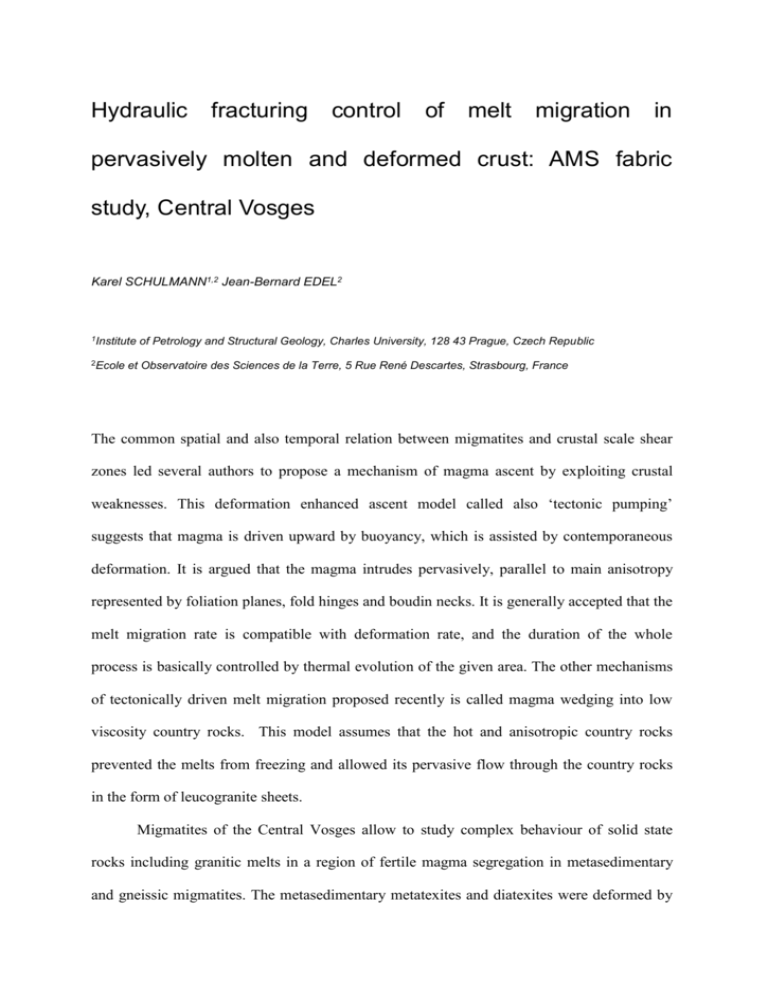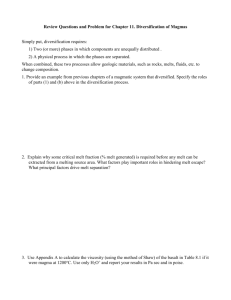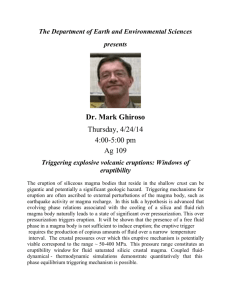Hydraulic fracturing control of melt migration in
advertisement

Hydraulic fracturing control of melt migration in pervasively molten and deformed crust: AMS fabric study, Central Vosges Karel SCHULMANN1,2 Jean-Bernard EDEL2 1Institute 2Ecole of Petrology and Structural Geology, Charles University, 128 43 Prague, Czech Republic et Observatoire des Sciences de la Terre, 5 Rue René Descartes, Strasbourg, France The common spatial and also temporal relation between migmatites and crustal scale shear zones led several authors to propose a mechanism of magma ascent by exploiting crustal weaknesses. This deformation enhanced ascent model called also ‘tectonic pumping’ suggests that magma is driven upward by buoyancy, which is assisted by contemporaneous deformation. It is argued that the magma intrudes pervasively, parallel to main anisotropy represented by foliation planes, fold hinges and boudin necks. It is generally accepted that the melt migration rate is compatible with deformation rate, and the duration of the whole process is basically controlled by thermal evolution of the given area. The other mechanisms of tectonically driven melt migration proposed recently is called magma wedging into low viscosity country rocks. This model assumes that the hot and anisotropic country rocks prevented the melts from freezing and allowed its pervasive flow through the country rocks in the form of leucogranite sheets. Migmatites of the Central Vosges allow to study complex behaviour of solid state rocks including granitic melts in a region of fertile magma segregation in metasedimentary and gneissic migmatites. The metasedimentary metatexites and diatexites were deformed by homogeneous viscous flow, but showing a complete continuity between pre-rheological critical melt percentage AMS fabrics and AMS fabrics associated with viscous magma flows. Metatexites with low proportion of melts (<50%) and metagraywacke mesosomes exhibit rather high degree of anisotropy associated with plane strain to oblate ellipsoid shapes. The leucosomes show plane strain ellipsoid shapes and weaker degree of anisotropy reflecting strain and complex deformation history associated with boudinage process. The diatexites and granites (>50% of melts) show very weak degree of anisotropy and highly variable ellipsoid shapes which may reflect undisturbed rotation of carriers of magnetic anisotropy (biotite) in freely moving melts. The AMS study of diatexites and heterogeneous granites showed consistent directions with regional extension, which was further used as direction of main pervasive flow. Mechanical behaviour of rocks with low ability to melt also depends on the volume of granitic magma. This was examined in two large gneissic domains surrounded by diatexites and heterogeneous granites. These domains show different AMS pattern of solid state gneissosity with respect to main pervasive magma flow. Detailed AMS study of rocks with low volume of melts confirmed presence of original steep anisotropy oriented in E-W direction preserved in the core of large gneissic domain. Towards the margin of this megaboudin (10 km in length and 5 km in width), the AMS of solid state annealed rocks document folding of original anisotropy by 100 m large buckle folds with long limbs close to the direction of surrounding pervasive magma flow. In addition, the AMS fabrics of leucocratic magma provide evidence that the anatectic leucosomes are aligned approximately parallel to the axial surface of folds suggesting magma injection perpendicular to the direction of active contraction (Vernon & Paterson, 2001). The study confirms connection between regional shortening and melt segregation along contractional localized shear zones clearly associated with process of buckling. The second megaboudin of gneissic rocks shows significantly higher proportion of magma. The AMS of solid state annealed rocks confirmed existence of large scale (10 to 100 metres) recumbent folds with hinges parallel to main stretching direction of surrounding pervasive flow. However the fabric study of leucocratic melts show distribution along conjugate zones oriented in obtuse angle with respect to the solid-state anisotropy intersecting perpendicularly to the axes of large-scale folds. We follow Cosgrove (1997) in assumption considering hydraulic fracturing in anisotropic material, which was based on layer-normal compression analogous models introduced by Kidan and Cosgrove (1996). We suggest that the anisotropy and magnitude of differential stress are the main factors influencing melt distribution at this stage. We also argue that the melt moved through and out of the partially molten anisotropic system by hydraulic fracturing along the planar, horizontal stretching fabric and gently inclined normal kink-bands (extensional shears). This study shows that the AMS method is a powerful tool to investigate the tectonically driven magma mobility. We believe that the degree of deformation connected with early buckling and later on with shortening perpendicular to the main anisotropy are the main factors controlling magma behaviour and distribution in partially molten crust. References: Cosgrove, J.W. 1997. The influence of mechanical anisotropy on the behaviour of the lower crust. Tectonophysics 280, 1-14. Kidan, T.W. & Cosgrove, J.W. 1996. The deformation of multilayers by layer-normal compression; An experimental investigation. Journal of Structural Geology 18, 461474. Vernon, R.H. & Paterson ,S.R. 2001. Axial- surface leucosomes in anatectic migmatites Tectonophysics 335,183-192.







